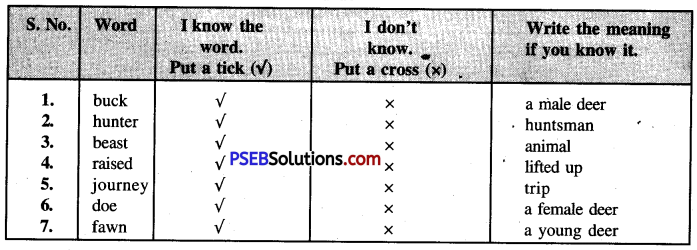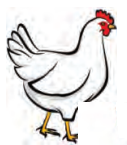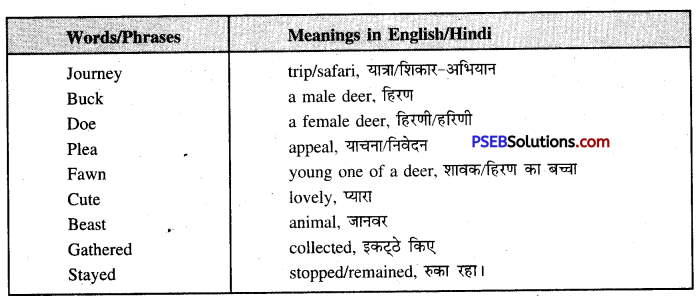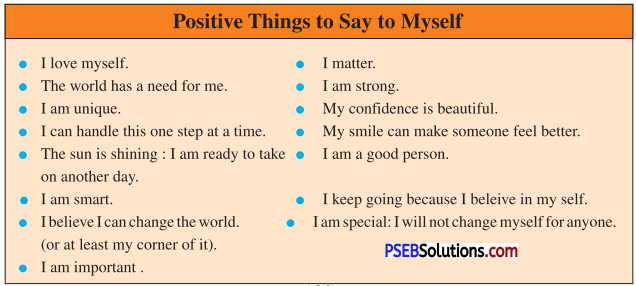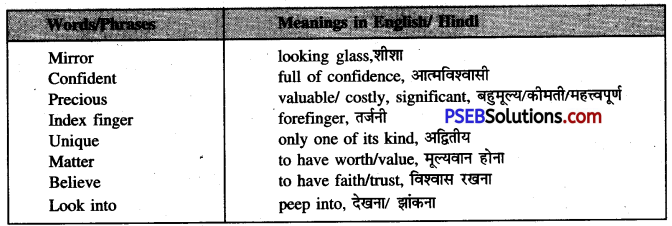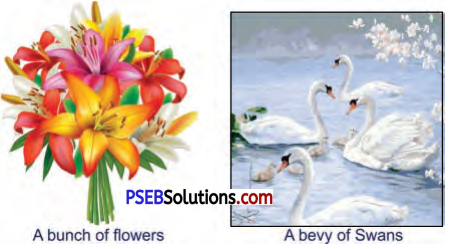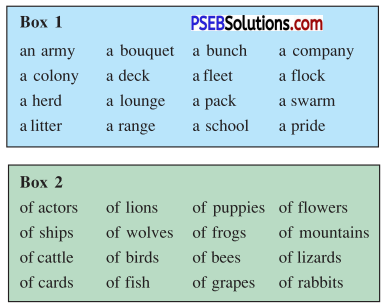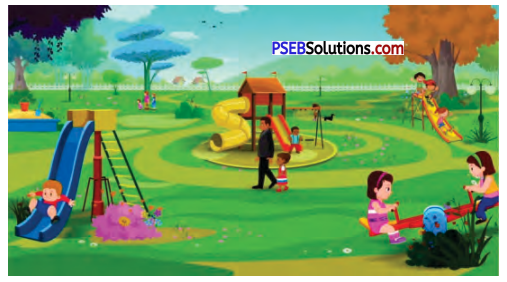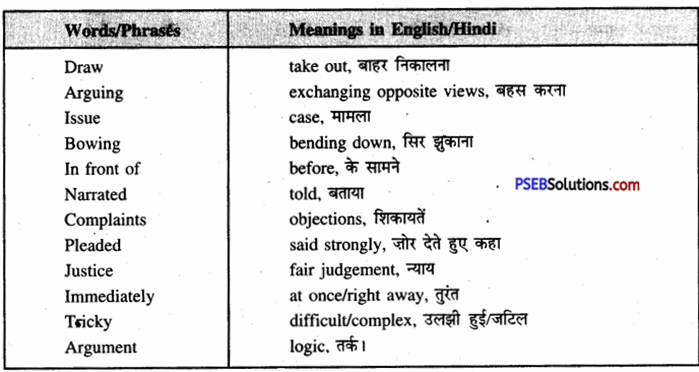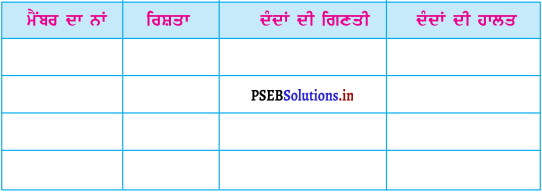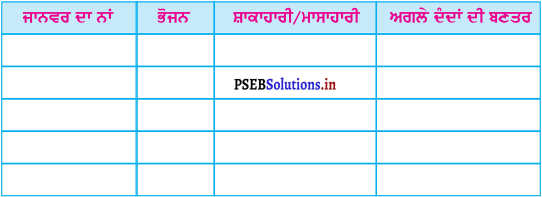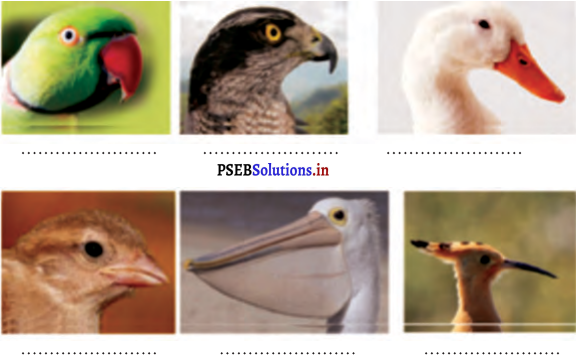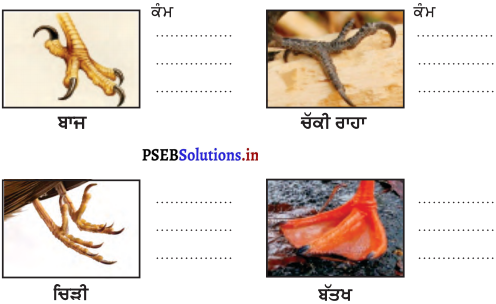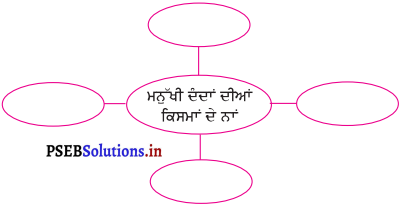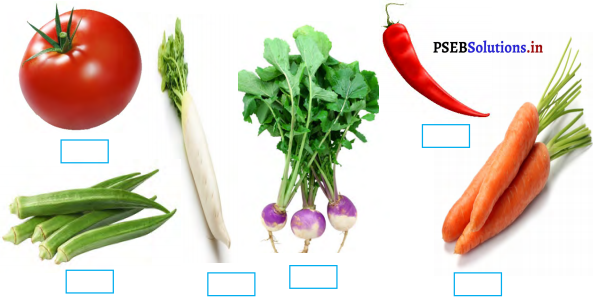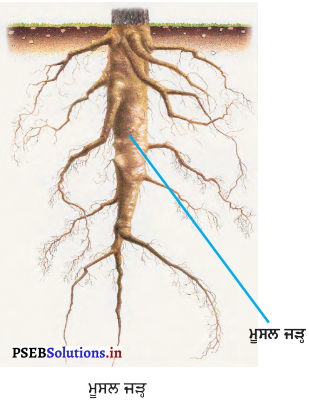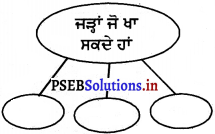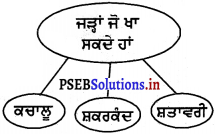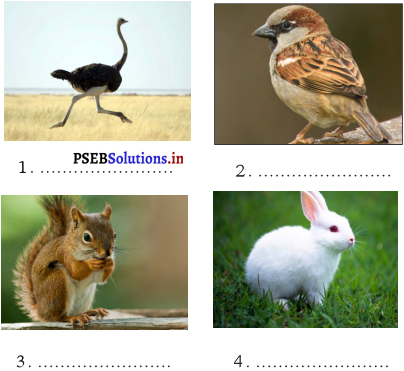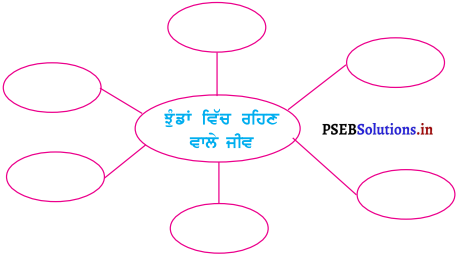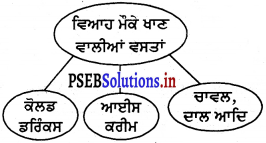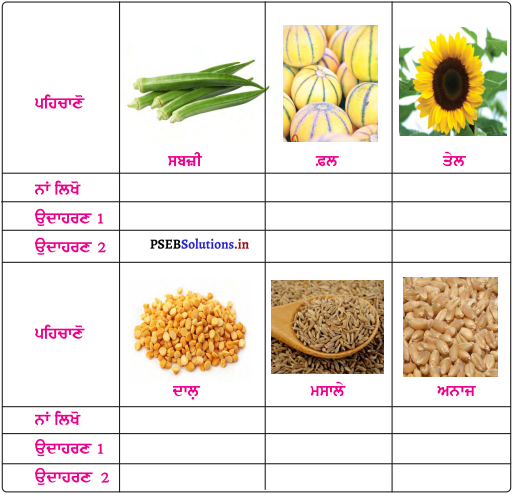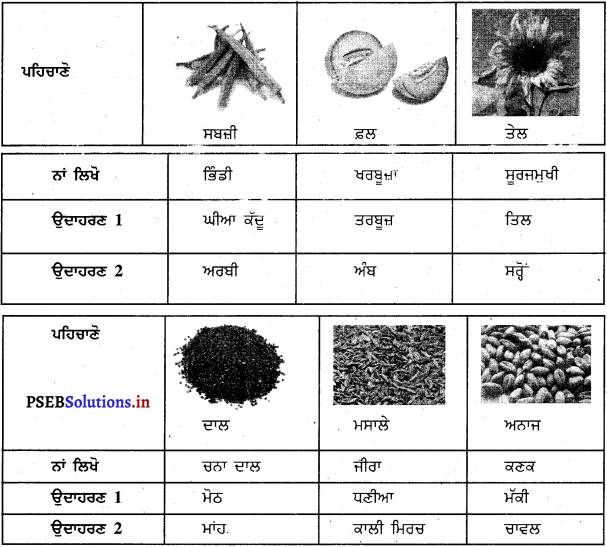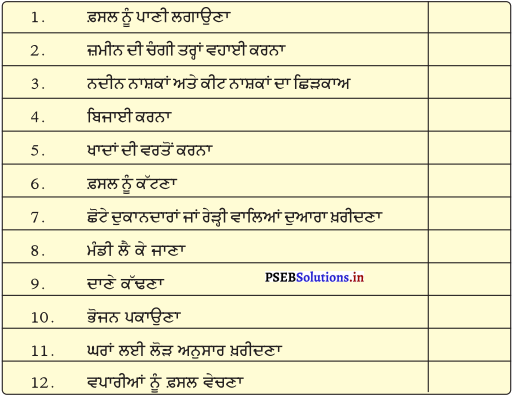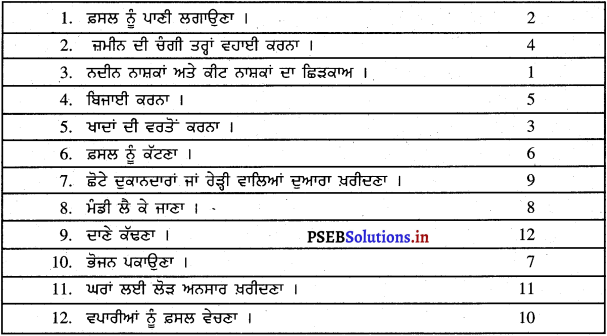Punjab State Board PSEB 6th Class English Book Solutions Chapter 4 The Peacock and the Crow Exercise Questions and Answers.
Class 6th English Solutions Chapter 4 The Peacock and the Crow Question Answers
The Peacock and the Crow Class 6 Questions and Answers
Activity 1.
Look up the following words in a dictionary. You should seek the following information about the words and put them in your WORDS notebook.
1. Meaning of the word as used in the lesson (Adjective / Noun / Verb etc.).
2. Pronunciation (The teacher may refer to the dictionary or the mobile phone for correct pronunciation).
3. Spellings
| feathers | perching | collected |
| reflection | ignoring | humiliated |
| accepted | realized | apologized |
![]()
Vocabulary Expansion
Activity 2.
Look at the following pairs of words. They have the same meaning but different forms. Column 1 has the second form and column 2 has the first form. Fill up blank spaces in Column 2 with the first form of the given words. A few have been done for you.
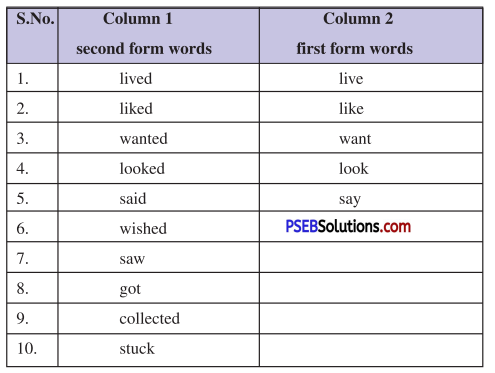
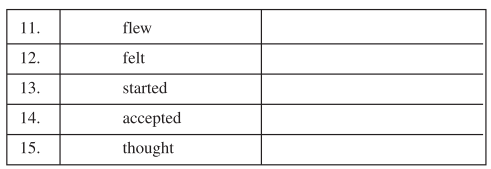
Answer:
| S.No. | Column 1 second form words |
Column 2 first form words |
| 1. | lived | live |
| 2. | liked | like |
| 3. | wanted | want |
| 4. | looked | look |
| 5. | said | say |
| 6. | wished | wish |
| 7. | saw | see |
| 8. | got | get |
| 9. | collected | collect |
| 10. | stuck | stick |
| 11. | flew | fly |
| 12. | felt | feel |
| 13. | started | start |
| 14. | accepted | accept |
| 15. | thought | think |
Learning to Read and Comprehend
Activity 3.
Read and write answers.
Question 1.
What did the crow not like about himself ?
कौए को अपनी क्या चीज़ पसंद नहीं थी ?
Answer:
The crow did not like his black feathers.
![]()
Question 2.
Who did he want to be like? Why ?
वह किस जैसा बनना चाहता था और क्यों ?
Answer:
He wanted to be like a peacock because a peacock is a beautiful bird.
Question 3.
What did he say to the other crows ?
उसने अन्य कौओं से क्या कहा?
Answer:
He told the other crows that he did not belong to them. He asked them to stay away from him.
Question 4.
What did the crow see on the ground ?.
कौए ने धरती पर क्या देखा?
Answer:
The crow saw many peacock feathers on the ground.
Question 5.
What did he do with the peacock feathers ?
उसने मोर के पंखों का क्या किया?
Answer:
He stuck them into his wings, his tail and on this head.
![]()
Activity 4.
1 Who said to whom ?
1. “You look so dull and plain. Look how beautiful the peacocks are.”
2. “Look at my beautiful feathers. I don’t belong to you anymore. So, stay away from me”.
3. “Peacock feathers will not make you a peacock.”
4. “We should accept ourselves the way we are.”
5. “You will not be able to fly properly with these stuck on your body”.
Answer:
1. The crow to his fellow crows.
2. The crow to his fellow crows.
3. The peacocks to the crow.
4. The old wise crow to the crow.
5. The old wise crow to the crow.
Activity 5.
Complete the sentences in the following blanks.
1. One day perching on his tree,
Hints : …………….. the crow saw many peacock feathers on the ground.
2. The crow flew to the river to
Hints : …………….. see his reflection.
3. The peacocks knew that
Hints : …………..he was not one among them. He was a crow.
4. He tore off the entire peacock feathers
Hints : ………………. that were stuck to his feathers.
5. Then, he went to his friends
Hints : …………… and apologized for insulting them.
नोट : विद्यार्थी पूरा वाक्य लिखें।
![]()
Learning Language
Preposition
A preposition is a word placed before a Noun or Pronoun to indicate place, direction.
किसी Noun या Pronoun से पहले प्रयोग होने वाला शब्द, जो स्थान दिशा आदि दर्शाता है को Preposition कहते है|
on in, into, upon, between, among, under, in front of, beside, behind, आदि शब्द Prepositions है।

Punctuation
In this lesson, we will continue with punctuation and concentrate on Full stop, Comma, Question Mark and Exclamation mark.
1. The full ( . ) stop is used in the following cases (स्थितियों) :
(a) to mark the end of an assertive or imperative sentence such as :
(i) The baby is sleeping. (assertive or positive)
(ii) Don’t make a noise here. (imperative-order or request)
(b) to mark the abbreviations such as M.A., P.M.
(c) to mark the initials such as Mr. J.D. Kohli, Mrs. B. Sharma
2. The comma (,) is used in the following cases :
(a) to separate words from each other :
1. She is a tall, pretty and gentle girl.
2. Meera has pens, pencils papers and books.
3. We do our work neatly, quickly and correctly.
4. My brother was born on Friday, March 26, 1984.
A comma is generally not used before ‘and’.
प्रायः ‘and’ से पहले comma तही लगया जात |
![]()
3. Question Mark (?) is used at the end of a question.
1. What is your name?
2. Do you have an umbrella ?
3. She is beautiful, isn’t She ?
4. Did Saawan go to Mumbai ?
4. Exclamation mark (!) is used to show shock, surprise or happiness, sadness, etc.
1. What a lovely place !
2. She is beautiful !
3. Wow!
4. Oh!
4. Hurray!
Activity 6.
Put comma, fullstops, capitals, question marks in the sentences given below wherever required.
1. my name is ali and i come form malerkotla
2. my favourite color is blue what is yours
3. i have a dog its name is caesar
4. my sisters name is manju she is sixty four.
5. my phone number is 260086 ·
6. her uncle hemant is from gurdaspur in punjab
7. i am not from chandigarh, i am from ludhiana in punjab
8. kumar is from australia he lives in melbourne
9. do you like tea or coffee
10. please get biscuits vegetables fruits and some nuts from the market
Answer:
1. My name is Ali and I come from Malerkotla.
2. My favourite color is blue. What is yours?
3. I have a dog. Its name is Caesar.
4. My sister’s name is Manju. She is sixty four.
5. My phone number is 260086.
6. Her uncle, Hemant is from Gurdaspur in Punjab.
7. I am not from Chandigarh; I am from Ludhiana in Punjab.
8. Kumar is from Australia. He lives in Melbourne.
9. Do you like tea or coffee ?
10. Please get biscuits, vegetables, fruits and some nuts from the market.
![]()
Reading a short Passage
Activity 7.
Read the following story.
Self Realisation A lioness died soon after giving birth to a cub. A mother sheep saw the cub and felt pity for it. She raised the cub among her lambs. However, the naughty lambs made fun of him for his different looks. The cub felt sad about this.
One day, a lion attacked the herd. He was surprised to see the cub running away with the herd. He caught the cub and roared angrily. “Why are you running with the sheep ?” he asked the cub. The cub was scared. He said, “Please don’t kill me. I am a very young lamb.”‘
The lion dragged the cub to a river. “Look at your reflection,”he roared. The cub was surprised. He realized that he was not a sheep but a mighty lion. He became so happy that he started roaring like a lion. One should keep trying to realize one’s worth and hidden skills. Success lies in knowing yourself like the young cub.
1. Answer the following
1. Who raised the cub ?
2. Why was the cub not happy ?
3. What did the cub do on seeing the lion ?
4. What did the lion do?
5. What did the cub see in the river ?

Answer:
1. A mother sheep raised the cub.
2. The cub was not happy because the naughty lambs made fun of him.
3. He started running with the herd of sheep.
4. The lion caught the cub and asked him why he was running.
5. The cub saw his reflection in the river.
![]()
2. Fill in the blanks using a word from the passage.
1. The cub realized that it was not a …………….. but a ……………
2. We should try to realize our …………….. and ……………… skills.
3. One should keep ……………. to realize one’s …………….. and hidden ……………
Answer:
1. sheep, mighty lion,
2. worth, hidden,
3. trying, skills.
3. Choose the correct option :
Question 1.
The cub saw his reflection and realized that it was a ………
(a) lion
(b) tiger
(c) sheep
(d) wolf
Answer:
(a) lion
Question 2.
The lion caught the cub. What did he say to the cub ?
(a) Why are you running with the sheep ?
(b) Please don’t kill me.
(c) I am a very young lamb.
(d) You are a lion.
Answer:
(a) Why are you running with the sheep ?
Learning to Listen
Activity 8.
Dictation of words
The teacher will give students dictation of 10 words from the text. Students will write them in their notebooks.
Note : Do it yourself.
Learning to Speak
Activity 9 (Pairwork)
Speak the words used for dictation aloud with proper pronunciation.
Note : Do it yourself. Learning to Write
Activity 10.
Look at the picture given below and describe it in your words.
For the description, you may use the following words / phrases.
1. forest
2. trees
3. crow
4. fox
5. a piece of
6. cheese
Answer:
This is a lovely forest. There are many tall trees in it. A crow is sitting in a tree. He has a piece of cheese in its beak. There is a fox under the tree. It wants to get that piece. It will flatter the crow to sing. When the crow opens its beak, the piece of cheese will fall down. The fox will take it away to eat.
![]()
Comprehension Of Passages
Read the given passages and answer the Questions that follow each :
(1) Once there lived a crow who did not like his black feathers. He wanted to be like a peacock because the colourful feathers of the peacock looked very beautiful. “You look so dull and plain. Look how beautiful the peacocks are. I wish I were a peacock.” he would say to other crows.
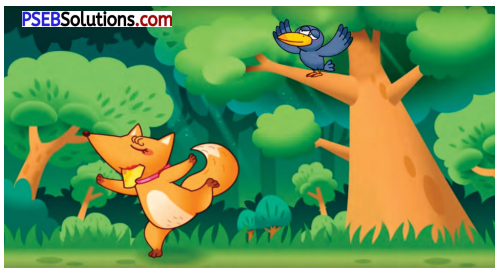
One day, perching on his tree, the crow saw many peacock feathers on the ground. The feathers looked very beautiful. Seeing those peacock feathers, he got an idea. He collected all the feathers and stuck them into his wings and the tail. He also put a few on his head to look like a peacock. He flew to a river to see his reflection.
(i) Why did the crow want to be like a peacock ?
कौआ मोर जैसा क्यों बनना चाहता था ?
(ii) What did he do with the peacock feathers ?
उसने मोर के पंखों का क्या किया ?
(iii) Choose true or false statements and write them in your answer book :
(a) The crow had beautiful feathers.
(b) The feathers of a peacock are colourful.
(iv) Complete the following sentences according to the meaning of the passage :
(a) The crow saw many peacock feathers ——-
(b) He collected all the feathers and ——- wings.
Or
Match the words with their meanings :
| (a) perch | sleep |
| (b) reflection | sit |
| shadow |
Answer:
(i) The crow wanted to be like a peacock because the colourful feathers of the peacock looked very beautiful.
(ii) He stuck the peacock feathers to his body.
(iii)
(a) False
(b) True.
(iv)
(a) The crow saw many peacock feathers on the ground.
(b) He collected all the feathers and stuck them into his wings.
Or.
(a) perch — sit
(b) reflection — shadow
![]()
(2) “Now I am also as beautiful as a peacock,” he said to himself. He thought that now he should live among the peacocks. So, he went to join the pride of peacocks but peacocks laughed at him. They did not accept him. The peacocks knew that he was not one among them.
He was a crow. “Peacock feathers will not make you a peacock,” they said to him.Sad and feeling insulted, he thought that his crow friends would be happy to see his new feathers. He returned to his fellow crows. None of his fellow crows accepted him.
They did not want him back because he had insulted them earlier. They also knew that he had been insulted by the peacocks. They also started laughing at him. They looked at his feathers and laughed at his face.
(i) Why did the crow think of living among the peacocks ?
कौए ने मोरों के बीच रहने की क्यों सोची ?
(ii) Why did his fellow crows not want him back ?
उसके साथी कौए उसकी वापिसी क्यों नहीं चाहते थे ?
(iii) Choose true or false statements and write them in your answer book :
(a) Peacock feathers will make a crow peacock.
(b) The fellow crows laughed at the crow when he came back.
(iv) Complete the following sentences according to the meaning of the passage :
(a) None of his fellow crows ………
(b) They looked at his feathers and …………
Or
Match the words with their meanings :
| (a) Accept | make fun |
| (b) Laugh at | to be happy |
| own |
Answer:
(i) The crow thought so because he thought that he was as beautiful as a peacock.
(ii) His fellow crows did not want him back because he had insulted them earlier.
(iii)
(a) False
(b) True
(iv)
(a) None of his fellow crows accepted him.
(b) They looked at his feathers and laughed at his face.
Or
(a) Accept — own
(b) Laugh at — make fun
![]()
(3) Then, an old and wise crow came and told him, “We should accept ourselves the way we are. Don’t try to copy others, blindly. Peacock feathers are good for peacocks only. For crows the peacock feathers are heavy. You will not be able to fly properly with these stuck on your body. I hope you have learnt your lesson.”
The crow realized his mistake. Though he thought that he was looking handsome, he found it difficult to fly properly. He tore off the entire peacock feathers that were stuck to his feathers. He accepted his plain self. Then, he went to his friends and apologized for insulting them. They accepted him and became friends again. The crow was finally happy.
(i) What was the advise of the wise crow ? Write two sentences.
बुद्धिमान कौए की क्या शिक्षा थी ? दो वाक्य लिखें।
(ii) Why did the crow tear off his peacock feathers ?
कौए ने अपने मोर पंख क्यों उखाड़ फेंके ?
(iii) Choose true or false statements and write them in your answer book :
(a) The crow thought that he was looking handsome.
(b) The crow found it easy to fly properly.
(iv) Complete the following sentences according to the meaning of the passage.
(a) He accepted his ……………..
(b) They accepted him and ………..
Or
Match the words with their meanings :
| (a) realized | insulted |
| (b) tore off | removed |
| accepted |
Answer:
(i) His advise was : We should accept ourselves as we are. Don’t try to copy others.
(ii) He tore off his peacock feathers because he realized his mistake. He could not fly properly with peacock feathers.
(iii)
(a) True
(b) False
(iv)
(a) He accepted his plain self.
(b) They accepted him and became friends again.
Or
(a) realized – accepted
(b) tore off – removed.
![]()
Use Of Words/Phrases In Sentences
1. Apologise (say sorry) —
He apologised for his mistake.
उसने अपनी गलती पर खेद व्यक्त किया।
2. Laugh at (make fun) —
Don’t laugh at the poor.
गरीबों का मज़ाक मत उड़ाओ।
3. Accept (own/acknowledge) —
He accepted his mistake.
उसने अपनी गलती स्वीकार कर.ली।
4. Feathers (wings) —
The peacock has beautiful feathers.
मोर के पंख सुंदर होते हैं।
5. Ignore (neglect) —
Don’t ignore your studies.
अपनी पढ़ाई की उपेक्षा मत करो।
6. Perch (sit) —
Many sparrows are perching on the ground.
धरती पर बहुत सी चिड़ियां बैठी हैं।
7. Feel proud (take pride in) —
Don’t feel proud of your riches.
अपनी अमीरी पर अहंकार मत करो।
8. Entire (whole ) —
The entire hall was full.
पूरा हाल भरा हुआ था।
9. Realize (feel) —
She soon realized her mistake.
उसे जल्दी ही अपनी गल्ती का अहसास हो गया।
![]()
10. Handsome (pretty) —
My elder brother is very handsome.
मेरा बड़ा भाई बहुत सुंदर है।
Word Meanings:
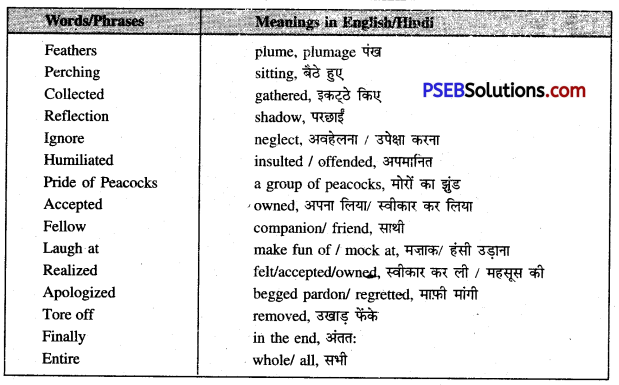
The Peacock and the Crow Summary in Hindi
Once there lived …………………. was a crow.
एक बार एक कौआ था जिसे अपने काले पंख अच्छे नहीं लगते थे। वह मोर जैसा बनना चाहता था क्योंकि उसे मोर के रंग-बिरंगे पंख बहुत ही सुंदर लगते थे। वह दूसरे कौओं से कहता, “तुम बहुत ही नीरस और साधारण दिखते हो। देखो मोर कितने सुंदर हैं। काश मैं मोर होता।” एक दिन कौआ अपने पेड़ की शाखा पर बैठा था तभी उसने बहुत से मोर पंख ज़मीन पर पड़े देखे। पंख बहुत ही सुंदर लग रहे थे।
मोर के पंखों को देखकर उसे एक विचार सूझा। उसने सारे पंखों को इकट्ठा किया और उसे अपने पंखों तथा पूंछ पर लगा लिया। उसने कुछ पंख अपने सिर पर भी लगा लिए ताकि वह मोर जैसा दिखाई दे। वह अपनी परछाई देखने के लिए नदी की ओर उड़ चला। उसने खुशी से कहा, “वाह! अब मैं मोर जैसा सुंदर दिखता हूँ।”उसने अपने आप से कहा, “अब मैं मोर जितना सुंदर हूँ।”
उसने सोचा कि अब उसे मोरों के साथ रहना चाहिए। इसलिए वह मोरों के झुंड में शामिल होने के लिए चला गया परन्तु मोर उस पर हंसने लगे। उन्होंने उसे अपनाया नहीं। मोर जानते थे कि वह उनके जैसा नहीं है। वह एक कौआ है।
![]()
Peacock feathers ………………. was finally happy.
उन्होंने उससे कहा, “मोर पंख तुम्हें मोर नहीं बना देंगे।” उदासी और अपमान (शर्मिंदगी) से भर कर उसने सोचा कि उसके कौए दोस्त उसके नए पंखों को देखकर खुश होंगे। वह अपने साथी कौओं के पास वापिस आ गया। उसके साथी कौओं में से किसी ने भी उसे अपना स्वीकार नहीं किया। वह नहीं चाहते थे कि वह वापिस आए क्योंकि वह पहले उनकी बेइज्जती कर चुका था। वे यह भी जानते थे कि मोरों ने उसकी बेइज्जती की हैं।
उन्होंने भी उस पर हंसना शुरु कर दिया। उन्होंने उसके पंखों को देखा और उसके सामने उसका मजाक उड़ाने लगे। तभी एक बुद्धिमान बूढ़ा कौआ आ गया और उसे कहां, “हम जैसे हैं हमें अपने आप को वैसा ही स्वीकार करना चाहिए। आँख मूंद कर दूसरों की नकल मत करो। मौरो के पंख केवल मोरों के लिए ही अच्छे हैं। कौओं के लिए मोर पंख भारी हैं।
उन्हें अपने शरीर पर लगा कर तुम ठीक ढंग से नहीं उड़ सकते। मुझे आशा है कि तुम्हें अपना सबक मिल चुका है।” कौए ने अपनी गलती स्वीकार कर ली। यद्यपि वह सोचता था कि वह सुन्दर दिख रहा है फिर भी उसके लिए उड़ पाना कठिन था। उसने अपने पंखों पर लगे सभी मोर पंख उखाड़ फेंके।
उसने अपने आपको साधारण (सादा) रूप में स्वीकर कर लिया। तब वह अपने मित्रों के पास गया और उनसे अपने द्वारा की गई बेइज्जती के लिए माफी मांगी। उन्होंने उसे अपना लिया और वे मित्र बन गए। अंततः कौआ खुश हो गया ।
Retranslation Of Isolated Sentences
1. He wanted to be like a peacock. — वह मोर जैसे दिखाई देना चाहता था।
2. You look so dull and plain. — तुम बहुत ही नीरस और साधारण दिखते हों।
3. The crow saw many peacock feathers on the ground. — कौए ने बहुत सारे मोर पंख ज़मीन पर पड़े देखे।
4. I look as beautiful as a peacock. — मैं मोर की तरह सुंदर लगता हूँ।
5. I don’t belong to you any more. — अब मेरा तुमसे कोई (संबंध) नाता नहीं है।
6. Peacock feathers will not make you a peacock. — मोर पंख तुम्हें मोर नहीं बना देंगे।
7. He returned to his fellow crows. — वह अपने साथी कौओं के पास वापिस आ गया।
8. We should accept ourselves the way we are. — हम जैसे हैं हमें अपने आपको वैसा ही स्वीकार कर लेना चाहिए।
9. I hope you have learnt your lesson. — मुझे आशा है कि तुम्हें अपना सबक मिल चुका है।
10. The crow realized his mistake. — कौए ने अपनी गलती मान ली।
11. The crow was finally happy.– अंतत: कौआ खुश हो गया।
English Class 6 Solutions PSEB Prose



